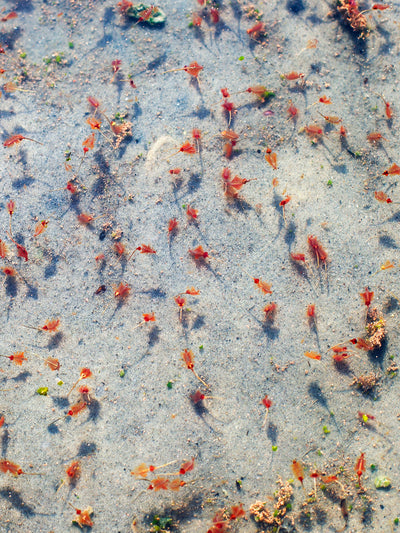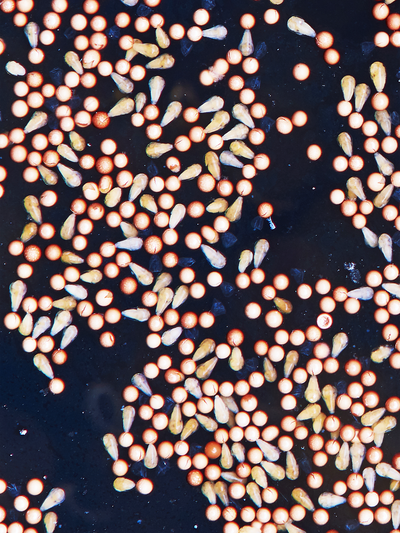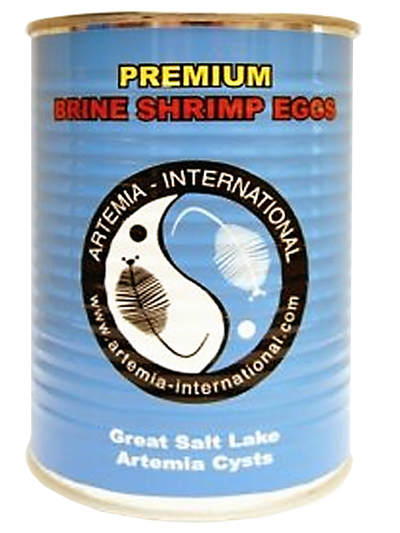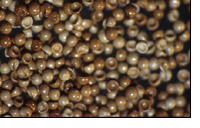




GSL ARTEMIA (BRINE SHRIMP EGGS)
These GSL Artemia are among the highest quality available anywhere. The GSL cysts are over-wintered, washed, dried, and tested under strict guidelines before categorizing into the different hatch rate categories.
Product Description
These GSL Artemia are among the highest quality available anywhere. The GSL cysts are over-wintered, washed, dried, and tested under strict guidelines before categorizing into the different hatch rate categories. Average nauplii size at hatching is 440 microns. Packed in 16oz (454g) vacuum sealed cans. Store in cool dry place (~4C).
Not all GSL Artemia (Brine Shrimp Eggs) are the same quality. What one company may label as 90% may be equivalent to another company's 75%. The true measure of quality is the nauplii per gram (NPG) count and not simply a hatch rate designation. Our GSL Artemia have hatch rates and NPG counts as shown below.
Quality Control
 100% Brine Shrimp (Artemia Franciscana) Cysts Origin: Great Salt Lake, Utah, USA
100% Brine Shrimp (Artemia Franciscana) Cysts Origin: Great Salt Lake, Utah, USA
Hatching Criteria - Hatching density of two grams of cysts per liter of saltwater, 28 C incubation temperature, strong aeration and constant illumination over 24 hours. Cyst count is approximately 270,000 cysts per gram
| Artemia Quality | Hatching Percentage | Nauplii per Gram of Cysts |
| Grade AA (premium) | 90% | 260,000 |
| Grade A | 85% | 253,000 |
| Grade B | 80% | 245,000 |
| Grade C | 75% | 235,000 |
| Grade C | 70% | 210,000 |
| Grade D | 65% | 190,000 |
| Grade D | 60% | 180,000 |
Biometrics
| Diameter of Hydrated Cyst | 250 microns (average) |
| Length of Nauplii (Instar I) | 470 microns (average) |
Processing and Packaging - The raw cysts are harvested directly from the Great Salt Lake (Utah), stored at sub-zero temperatures, washed, and dehydrated in modern fluidized bed dryers. The dried cysts are then vacuum-sealed in tin cans (15 or 16 oz.) and packed 12 per case. Storage temperature of finished product is 4 C.
Aquaculture Feed Application - Live feed for larval and post-larval shrimp and fish. Not for human consumption.
Storage - For best results, store under refrigerated conditions between 0 C and +6 C for up to six months. Otherwise, store in a cool place where temperatures will not exceed 28 C for up to 30 days. Keep out of direct sunlight.
Hatching FAQ
What are the guidelines for Artemia cysts?
Salinity - 20 - 30 parts per thousand (ppt) salt solution or approximately 1-2 tablespoons of rock salt per quart (or liter) of water. This equates to around 1.015-1.020 specific gravity. A 20% (or around 1/2 teaspoon per quart) concentration of Epson salt or magnesium sulfate can be added to further buffer the hatching solution.
Temperature - Optimum temperature for a 24 hour complete hatch 26-28° C. Lowering the temperature would result in a longer hatching time. Do not exceed 30°C.
Light - Illumination is necessary to trigger the hatching mechanism within the embryo within the first few hours of incubation. Maintaining a light source during the entire incubation period is recommended to obtain optimum hatch results and for temperature control.
Aeration - Constant aeration is also necessary to provide sufficient oxygen levels for the cysts to metabolize and hatch. A minimum of 3 parts per million dissolved oxygen during the incubation is recommended. Strong aeration will not damage or hurt the brine shrimp cysts or nauplii.
pH - A starting pH of 8.0 or higher is recommended. If pH drops below 7.5 during incubation, add a teaspoon of sodium bicarbonate or a pH buffer to raise it above 8.0.
Stocking Density - 2 grams per quart or approximately one level tablespoon of cysts per quart is recommended. A higher stocking density will result in a lower % hatch.
Hatching Cone - Flat bottom hatching vessels should be avoided. Cone or "V" bottomed containers are best to insure that the cysts remain in suspension during hatching. Be sure to thoroughly wash the hatching cone with soap and water and allow to air dry between uses.
How do I harvest the baby brine shrimp?
To harvest the baby brine shrimp or nauplii, simply shut off the air and wait a few minutes for the shells and nauplii to separate. The shells will float to the surface and the live nauplii will go to the bottom of the cone towards the light source. Once separated, the nauplii can be siphoned from the bottom or drained from the bottom of the cone through the air tubing.
Technical Information
ARTEMIA CYSTS ANALYSIS Great Salt Lake (GSL) Strain (Artemia Franciscan)
1) Proximate Analysis
| Protein | 50.0% minimum |
|---|---|
| Fat | 19.0% minimum |
| Fiber | 2.0% maximum |
| Ash | 6.1% minimum |
| Moisture | 8.0% maximum |
2) Fatty Acid Profile
| C18:0 | Stearicc | 9.0 mg/g |
| C18:1 | Oleic | 27.2 |
| C18:3 | Linoleic | 9.1 |
| C18:4 | Octadecatetra | 11.2 |
| C20:0 | Arachidic | 1.1 |
| C20:4 | Arachidonic | 4.5 |
| C20:3 | Eicosatrienoic | 2.7 |
| C20:5 | Eicosapentaenoic (EPA) | 4.1 |
| C22:6 | Docosahexaenoic (DHA) | 0.1 |
| Total | Omega-3 Fatty Acids | 4.0 |
3) Microbiological Analysis
| Marine Bacteria (CFU/g.) | 10,000 maximum |
| Yeasts/Molds (CFU/g.) | 1,000 maximum |
| Coliforms (MPN/g.) | 10 maximum |
| E. coli | Negative |
| Salmonella | Negative |
| V. cholerae | Negative |
4) Heavy Metals (microgram/gram)
| Cadmium | 0.5 maximum |
| Copper | 6.0 maximum |
| Lead | 0.8 maximum |
| Mercury | 0.3 maximum |
5) Pesticides (microgram/gram)
| Chlorinated Hydrocarbons | 0.03 maximum |
| Organo-Phosphates | 0.01 maximum |
| PCB — Total | 0.01 maximum |
| Trichloroethylene | 0.01 maximum |
The following were not detected (detection level = 10 ppb):
HCB, BHC, LINDANE, HEPTACHLOR, ALDRIN, HEPTACHLOR EPOXIDE, DDE, DIELDRIN, ENDRIN, DDD, DDT, MIREX, METHOXYCHLOR, CHLORDANE, TOXAPHENE, DIAZINON, METHYL PARATHION, MALATHION, ETHYL PARATHION, ETHION, AND RONNEL.

